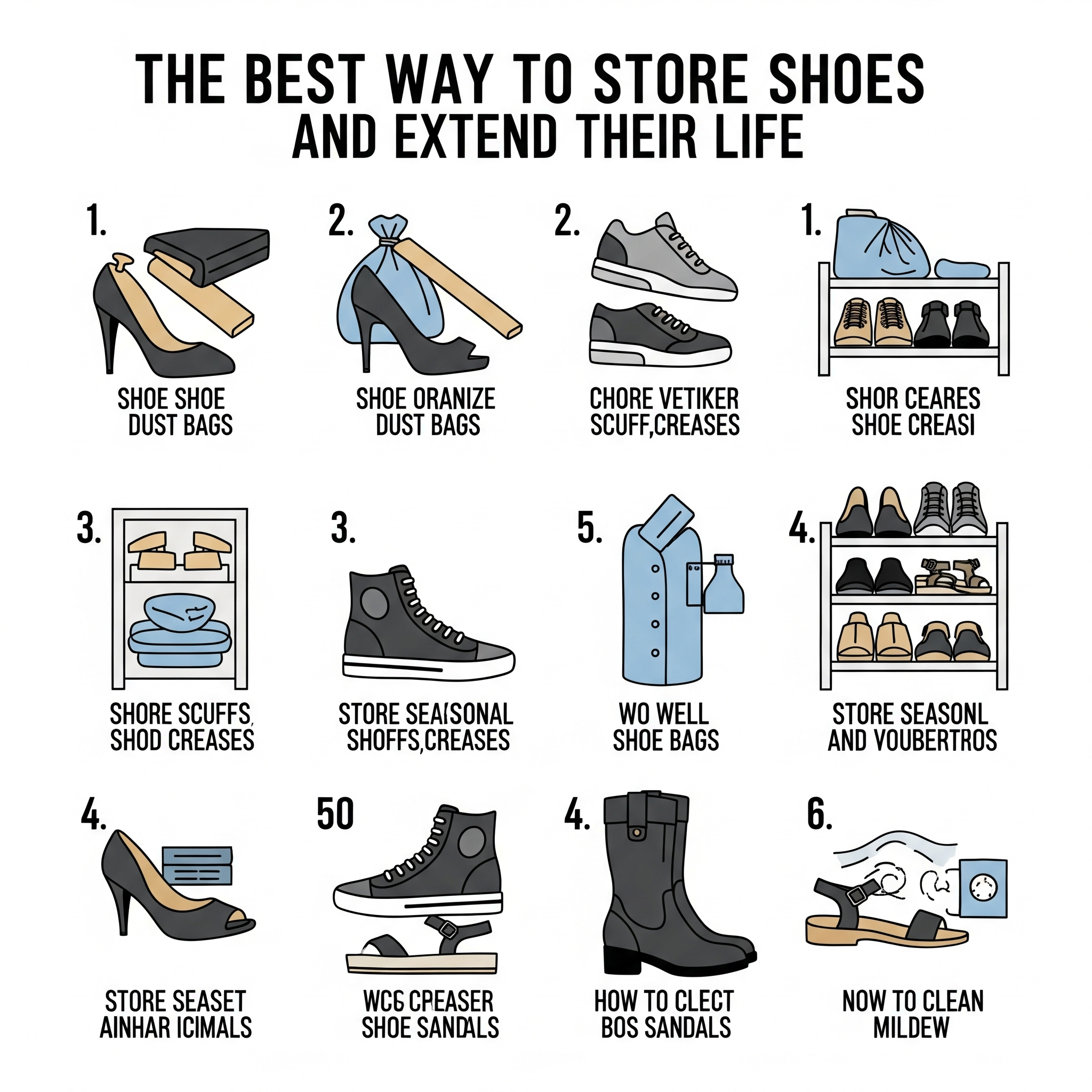If you’re someone who loves shoes—whether you’re into sneakers, stilettos, boots, or loafers—one thing’s for sure: proper storage can make all the difference in how long your shoes last. While many of us invest time and money in buying the right footwear, we often overlook the importance of storing them correctly. Bad storage habits can lead to fading, creasing, odors, or even mold growth.
In this blog post, we’ll break down the best ways to store shoes and extend their lifespan, with practical tips and product suggestions. You’ll also find answers to some common shoe storage questions at the end.
Why Shoe Storage Matters
Shoes go through daily wear and tear. Without proper care, they can lose their shape, smell unpleasant, and become damaged well before their time. The way you store your shoes can:
- Help maintain their structure and shape
- Prevent odor, mold, and mildew
- Protect from sunlight and humidity damage
- Reduce wear and tear between uses
- Keep your space organized and clutter-free
For anyone who wants their favorite pair to last for years—not months—shoe storage is a must.
Clean Before You Store
Before even thinking about storage, make sure your shoes are clean.
- Remove dirt and dust with a brush or damp cloth.
- For leather, use a leather cleaner or conditioner.
- For sneakers, gently scrub the soles and uppers and let them dry.
- Always allow shoes to air dry fully before storing them, especially if they’ve been exposed to moisture or sweat.
Damp shoes are breeding grounds for bacteria and mold, which can ruin the material and smell unpleasant.
Use Shoe Trees or Stuffing
Maintaining the original shape of your shoes is crucial for comfort and longevity.
- Cedar shoe trees are the best option for leather shoes and boots. They help maintain the shape and absorb moisture and odors.
- For sneakers, heels, or casual shoes, acid-free tissue paper, rolled-up socks, or foam inserts can be used to stuff the toes.
- Avoid newspaper stuffing, as the ink can transfer to your shoes over time.
Preserving shape means fewer creases, better fit, and a longer life for your shoes.
Store in the Right Environment
Shoes are sensitive to their surroundings. Ideally, shoes should be stored in a cool, dry, and dark place.
Avoid storing shoes in:
- Direct sunlight – which causes fading
- Damp areas – like basements or attics, which promote mold
- Plastic bags – which trap moisture
If you must store shoes in a garage or closet with limited airflow, consider using moisture absorbers like silica gel packets or activated charcoal bags to keep the area dry.
Use the Right Storage Solutions
Choosing the right type of storage solution is essential. Here are some popular and effective options:
1. Clear Shoe Boxes
- Ideal for visibility and protection.
- Great for sneakers or delicate heels.
- Choose ventilated boxes to prevent moisture buildup.
2. Shoe Racks
- Best for daily-use shoes.
- Allows shoes to breathe and keeps them accessible.
3. Over-the-Door Organizers
- Perfect for tight spaces or small apartments.
- Best for lightweight shoes like flats or sandals.
4. Under-Bed Shoe Storage
- Great for seasonal storage.
- Use boxes with dividers to keep shoes separated and organized.
5. Boot Shapers or Hangers
- Prevent tall boots from slouching or creasing.
- Boot hangers can save space and keep your closet tidy.
Rotate Seasonally
Storing all your shoes together year-round can create unnecessary clutter and reduce the lifespan of off-season pairs.
- Store seasonal shoes (like winter boots in summer) in labeled boxes or containers.
- Place them in a cool, dry area away from daily traffic.
- For long-term storage, stuff shoes with paper and use dust bags or cloth covers to protect them from dust and UV rays.
Label Everything
This is a simple yet often overlooked step. Labeling helps you find the pair you want quickly without digging through every box.
- Use photo labels on the front of clear boxes.
- Or use a label maker to mark shoe type and size.
This saves time and keeps your storage system functional.
Don’t Stack Without Protection
Stacking shoes on top of one another can damage their shape, especially if they’re delicate or made from soft materials.
If you must stack:
- Use shoe bins or dividers.
- Place a cloth or dust bag between layers.
- Avoid placing heavy shoes on top of lighter or more delicate ones.
Deodorize Regularly
Even stored shoes can develop odors over time.
- Insert odor-fighting insoles or cedar balls.
- Use baking soda sachets to absorb smells.
- Let shoes air out every few weeks, especially if stored long term.
This keeps your collection smelling fresh and wearable anytime.
Avoid These Common Shoe Storage Mistakes
To extend the life of your shoes, be aware of these frequent errors:
- Storing dirty shoes
- Skipping moisture control
- Using airtight plastic containers without ventilation
- Stacking heavy shoes on top of others
- Neglecting shoe trees or stuffing
With just a few good habits, you can avoid these pitfalls and enjoy your shoes for much longer.
Final Thoughts
Taking care of your shoes doesn’t end when you take them off. Proper storage is an essential part of shoe maintenance that ensures they look better, smell fresher, and last longer. From using shoe trees and ventilated boxes to rotating your collection with the seasons, these small steps can help you protect your investment and preserve your favorite pairs.
So whether you’re organizing a walk-in closet or optimizing a studio apartment, the right storage system can make your life easier—and your shoes a lot happier.
FAQs About Shoe Storage
Q1: How should I store shoes for the long term?
For long-term storage, clean shoes thoroughly, stuff them to retain shape, and store them in breathable containers like cloth bags or ventilated boxes. Keep them in a cool, dry, dark area to prevent damage from light and moisture.
Q2: Is it okay to store shoes in plastic containers?
Plastic containers can be fine if they’re ventilated. Otherwise, they can trap moisture and lead to mold or odor. Add silica gel packs if using plastic bins for extra moisture protection.
Q3: What’s the best way to store leather shoes?
Leather shoes need to breathe, so avoid airtight containers. Use cedar shoe trees, clean and condition them regularly, and store them in cloth dust bags or ventilated shoe cabinets.
Q4: Can I stack shoes on top of each other?
It’s best to avoid stacking, especially delicate shoes. If stacking is necessary, use protective layers between pairs to avoid deformation or scratches.
Q5: How do I prevent odor in stored shoes?
Make sure shoes are completely dry before storage. Use deodorizers like baking soda sachets, cedar inserts, or activated charcoal pouches inside each shoe to neutralize odors over time.



